Introduction
Here are some examples of typical exercises for your condition. Start each exercise slowly. Ease off the exercise if you start to have pain. Your doctor or physical therapist will tell you when you can start these exercises and which ones will work best for you.
To prepare, make sure that your ball is the right size for you. When inflated and firm, it should allow you to sit with your hips and knees bent at about a 90-degree angle (like the letter L).
How to do the exercises
How to move on an exercise ball
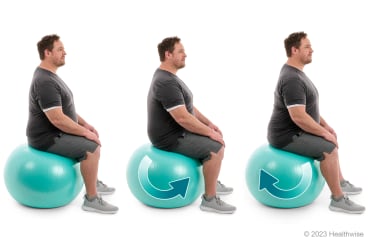
- Use this exercise to get used to moving on an exercise ball and to find your best sitting position.
- Sit comfortably on the ball with your feet about hip-width apart. If you feel unsteady, rest your hands on the ball near your hips.
- As you do this exercise, try to keep your shoulders and upper body relaxed and still.
- Using your trunk muscles to move your pelvis, roll the ball forward. This will round your back.
- Still using your stomach and back muscles, roll the ball back. You will arch your back.
- Repeat this rounding-arching motion a few times.
- Stop in between the two positions, where your back is not rounded or arched. This is called your neutral position.
Pelvic rotation (on a ball)
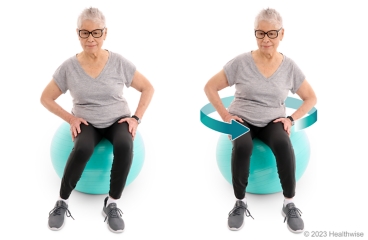
- Sit up straight on an exercise ball, with your feet about hip-width apart.
- Slowly rotate your hips in a circle pattern. Keep the movement focused at your hips.
- Repeat the circle in the other direction.
- Repeat 8 to 12 times in each direction.
How to sit on an exercise ball
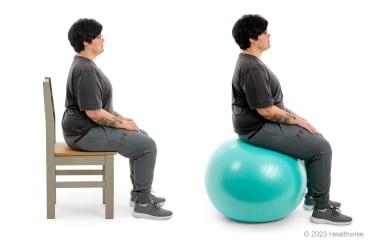
To find a stable, relaxed posture on an exercise ball:
- Sit on an exercise ball, with your feet flat on the floor in front of you and your heels directly under your knees. If you feel unsteady on the ball, practice on a chair first.
- Imagine that a string at the top of your head is pulling you straight up. Think of yourself as 2 inches taller than you are.
- Slightly tuck your chin.
- Keep your shoulders back and relaxed.
You can use this position as your starting point for ball exercises.
Knee extension on ball (core)
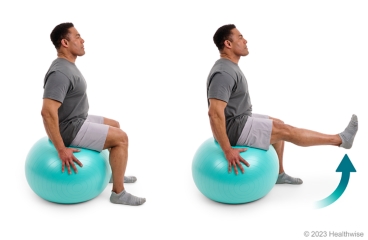
- Sit up straight on an exercise ball with your feet flat on the floor, hip-width apart. As you do this exercise, avoid slumping your shoulders and arching your back.
- Rest your hands on the ball near your hip or a steady object next to you. (If you feel very stable on the ball, rest your hands in your lap.)
- Slowly straighten one leg at the knee. Slowly lower it back down. Repeat with the other leg.
- Repeat 8 to 12 times with each leg.
Roll-up (with ball)
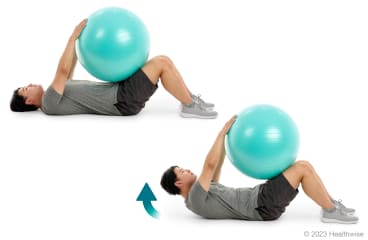
- Lie on your back on the floor, with your knees bent and your feet flat on the floor. (Or you can lie on any flat surface, such as a bed.)
- Lay the ball on your thighs. Rest your hands up high on the ball.
- Slowly tighten your belly muscles. Keep breathing and don't hold your breath. Raising your head and shoulder blades, roll the ball up your thighs. Exhale as you roll up.
- Keep your neck straight and don't press your chin to your chest. If this exercise is hard on your neck, gently support your lower head and upper neck with one hand. Don't use that hand to pull your head up.
- Hold for 1 to 2 seconds. Then slowly lower yourself back to the floor.
- Repeat 8 to 12 times.
Ball curl

- Lie on your back with your ankles resting on the ball, knees straight.
- Look up at the ceiling, and keep your chin relaxed. You can place a small pillow under your head or neck for comfort.
- Use your legs to roll the exercise ball toward you. Allow your knees to bend and move closer to your chest.
- Pause briefly, and then roll the ball to the starting position. Try to keep the ball rolling straight. You will feel the muscles in your lower belly working.
- Repeat 8 to 12 times.
Bridge with ball under legs
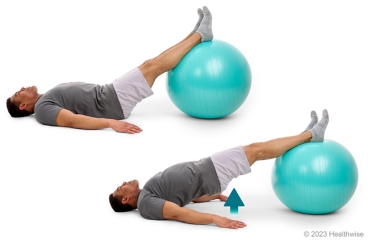
- Lie on your back with your legs up, calves resting on the ball. For more challenge, rest your heels on the ball.
- Look up at the ceiling, and keep your chin relaxed. You can place a small pillow under your head or neck for comfort.
- With your arms by your side, press your hands onto the floor for stability.
- Tighten your belly muscles by pulling your belly button in toward your spine.
- Push your heels down toward the floor, squeeze your buttocks, and lift your hips off the floor until your shoulders, hips, and knees are all in a straight line.
- Try to keep the ball steady. Hold for about 6 seconds. Keep breathing normally and don't hold your breath.
- Slowly lower your hips back down to the floor.
- Repeat 8 to 12 times.
Ball curl with bridge
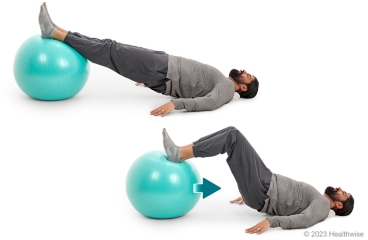
- Lie on your back with your ankles resting on the ball.
- Look up at the ceiling, and keep your chin relaxed. You can place a small pillow under your head or neck for comfort.
- With your arms by your side, press your hands onto the floor for stability.
- Tighten your belly muscles by pulling in your belly button toward your spine.
- Push your heels down toward the floor, squeeze your buttocks, and lift your hips off the floor until your shoulders, hips, and knees are all in a straight line.
- While holding the bridge position, roll the ball toward you with your heels. Keep your hips as level as you can.
- Pause briefly, and then roll the ball back out. Try to keep the ball rolling straight. You will feel the muscles in your lower belly working as you straighten your legs.
- Lower your hips.
- Return to your starting position.
- Repeat 8 to 12 times.
When you can keep your body and the ball steady throughout this exercise, you're ready for more challenge. Try keeping your hips raised while rolling the ball out, holding the bridge, and rolling back, a few times in a row.
Praying mantis
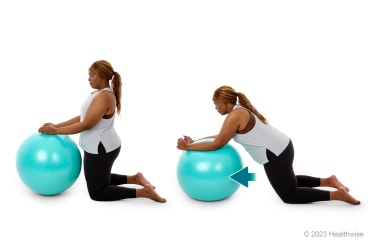
- Kneel upright with an exercise ball in front of you.
- Clasp your hands together and rest them on the ball in front of you. As you do this exercise:
- Press on the ball with your arms and slowly lean forward from your knees. This rolls the ball forward. You will bear most of your weight on your arms. If your back starts to ache, you've gone too far. Pull back a bit.
- Slowly roll back to the starting position.
- Repeat 8 to 12 times.
- Keep your back and hips straight and tighten your belly and buttocks muscles. Keep breathing and don't hold your breath.
- Keep your knees in place.
Walk-out plank on ball
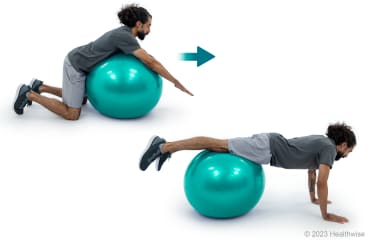
- Kneel in front of the ball and place your trunk over the ball. Use your legs to roll yourself forward until your hips are on top of the ball and your hands are on the floor.
- Straighten your legs behind you so that you are balancing on the ball. This is the plank position.
- Keep your body straight by tightening your belly and buttocks muscles. Keep your chin slightly tucked. Keep breathing and don't hold your breath.
- Walk your hands forward, rolling as far forward as you can without losing your balance or letting your hips drop. You may stop with the ball under your thighs, or even under your knees or shins.
- Hold for a few seconds. Then walk your hands back and return to the starting position, with your hips on top of the ball.
- Repeat 8 to 12 times.
Push-up (legs on ball)
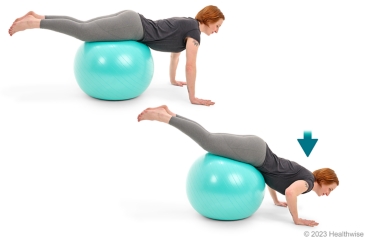
- Kneel in front of an exercise ball and lean forward over it. Place your hands on the floor in front of you.
- Walk your hands forward until your legs are straight on the ball. This is the plank position.
- When in plank position, hold your body straight by tightening your belly and buttocks muscles. Keep your chin slightly tucked. Keep breathing and don't hold your breath.
- Holding the plank position, roll as far forward as you can without losing your balance. You may stop with the ball under your thighs, or even under your knees or shins.
- Bend your elbows. Slowly lower your body toward the ground as far as you can without losing your balance. Keep your belly and buttocks muscles tight.
- Slowly straighten your arms.
- If your wrists hurt, try moving your hands a little farther apart so they're not right under your shoulders.
- Repeat 8 to 12 times.
Wall squat with ball

- Stand with your back facing a wall. Place your feet about shoulder-width apart.
- Place the exercise ball between your middle back and the wall. Move your feet out in front of you so they are about a foot in front of your hips. Tighten your belly muscles by pulling your belly button in toward your spine.
- Slowly squat down as if you are going to sit in a chair, rolling your back over the ball as you squat. The ball should move with you but stay pressed into the wall.
- Be sure that your knees do not go in front of your toes as you squat.
- Hold for about 6 seconds.
- Slowly rise to your standing position.
- Repeat 8 to 12 times.
Child's pose (with ball)
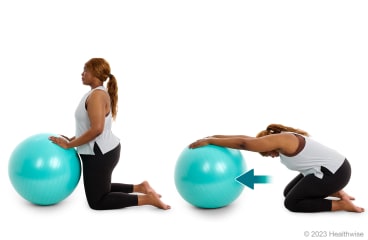
- Kneel upright with an exercise ball in front of you. Keep your back straight, and rest your hands on the ball.
- Breathe out as you bend at the hips, and slowly roll the ball forward. Lower your chest toward the ground, and drop your hips back toward your heels.
- Hold this position for 15 to 30 seconds.
- Return to the starting position.
- Repeat 2 to 4 times.
Current as of: July 24, 2025
Author: Ignite Healthwise, LLC Staff
Clinical Review Board
All Ignite Healthwise, LLC education is reviewed by a team that includes physicians, nurses, advanced practitioners, registered dieticians, and other healthcare professionals.

